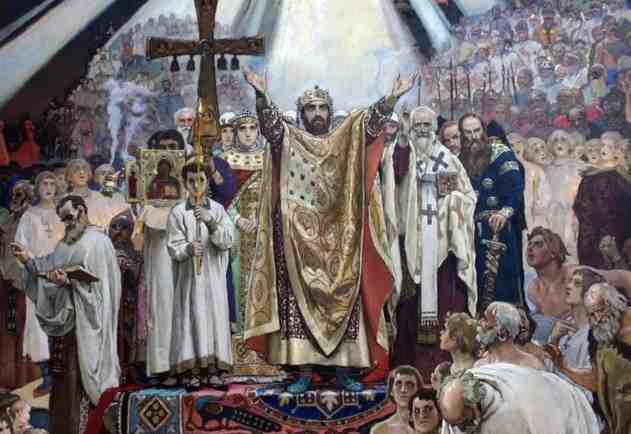Heaven on Earth

It came to pass that Vladimir, the grand Prince of Kiev, when he was still a pagan in 987 AD, he wanted to know which of the religion is the true one. He sent envoys of elders and wise men to different countries of the world to investigate different religions and report to him.
They went to various regions, and documented their remarks, among which: “Some hither and thither (looking left and right) like one possessed”… “Some have no joy among them, but only sorrow”… “Some perform many ceremonies in their temples; but we beheld no beauty there”
But when they arrived at Constantinople [Modern day Istanbul], and attended the liturgy in the Orthodox Church, they discovered what they were in search for, so they wrote:
“We knew not whether we were in heaven or on earth. For on earth there is no such splendor or such beauty, and we are at a loss how to describe it. We only know that God dwells there among men, and their service is fairer than the ceremonies of other nations, for we cannot forget that beauty.”
This liturgy was at the church of “Agia Sofia” [the Holy Wisdom], which later was turned into a Mosque, and now a museum. At that time, Agia Sofia was served by 80 priests, 150 deacons, 40 deaconesses, 70 Epideacon (subdeacon), 160 Ognostis (Readers), and 100 Epsaltos (hymnist). This one liturgy was the reason for Russia to enter into the Christian Orthodoxy. Today The Russian Orthodox Church has the largest Orthodox congregation in the world (more than 160 millions), albeit it is a part of the Chalcedonian family.
This historical even gives us an idea about the ability of the liturgical service in the Orthodox Church (Liturgy, Psalmody, Glorification, ritual prayers, etc.) to express the faith of the church, her ability to change hearts, and attract souls to the bosom of Christ. The orthodox person receives, and gets saturated with, his faith through the liturgy. And he understands his dogma through the living worship amidst the church. Therefore, he who wants to understand Orthodoxy, ought to not only read about it in books, but should simply immerse himself in its liturgical life. As Philip mentioned to Nathaniel in the past, “Come and see” (John 1:46), likewise the church tells us today. This is the slogan of orthodoxy: “Come and See.”
Today, is the first Sunday of the blessed month of Kyahk, a month rich of praises and glorification of the Mother of God and the divine incarnation, and we concluded it by the celebration of the Holy Nativity. In this month, the church prepares for us an environment fervent in spirit and filled with prayers, praises, and vigils. Everyone can participate in it to nurture the heart, be fervent in spirit, and to have a taste of heaven while still on earth.
The praises of the month of Kyahk are rich and diverse. It offers glorification of God the lover of mankind, beatification of Saint Mary, spiritual songs that stimulate the heart to repent, and praising the work of the Holy Spirit in the lives of Saint Mary and the saints. Additionally, it offers a great collection of meditations and expositions for the Biblical symbols of the divine incarnation in the form of beautiful psalmodies. It explains the unique human model that offered to God a human form to unit with humanity, I mean the Mother of God, the pure Saint Mary.
The praises of Kyahk are a source of joy, spiritual richness and spiritual fervency. Blessed is he who gobbles form it as much as he can throughout this month. I truly believe that he would enjoy Heaven on Earth.